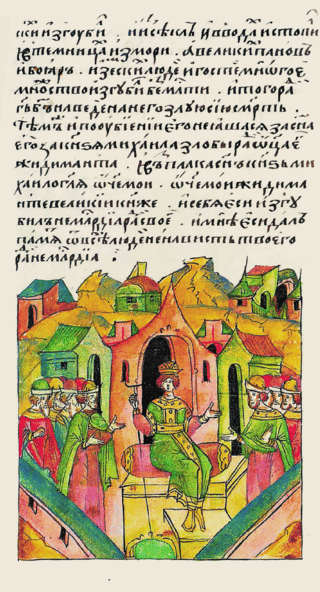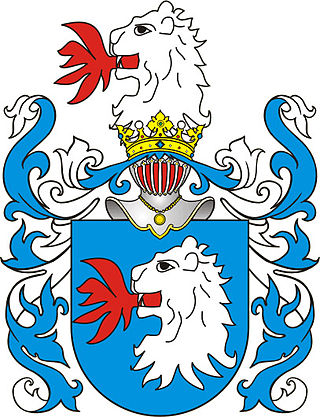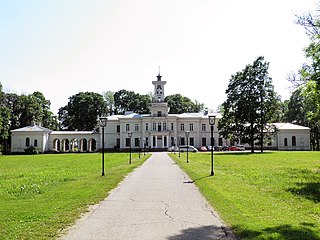
The Grand Duchy of Lithuania was a sovereign state in northeastern Europe that existed from the 13th century, succeeding the Kingdom of Lithuania, to the late 18th century, when the territory was suppressed during the 1795 partitions of Poland–Lithuania. The state was founded by Lithuanians, who were at the time a polytheistic nation of several united Baltic tribes from Aukštaitija, which by 1440, became the largest European state controlling an area from the Baltic Sea in the north to the Black Sea in the south.

The Nobility of the Grand Duchy of Lithuania or the Szlachta of the Grand Duchy of Lithuania was historically a legally privileged hereditary elite class in the Grand Duchy of Lithuania and Polish Lithuanian Commonwealth consisting of Lithuanians from Lithuania Proper; Samogitians from Duchy of Samogitia; following Lithuania's eastward expansion into what is now Belarus, Ukraine and Russia, many ethnically Ruthenian noble families (boyars); and, later on, predominantly Baltic German families from the Duchy of Livonia and Inflanty Voivodeship.

The Lipka Tatars are a Turkic ethnic group who originally settled in the Grand Duchy of Lithuania at the beginning of the 14th century.
Karijotas or Koriat was the Duke of Navahrudak and Vaŭkavysk, one of the sons of Gediminas, Grand Duke of Lithuania.

Lithuania is now a country in the Baltic region of Europe.

Michael Žygimantaitis was pretender to the throne of the Grand Duchy of Lithuania and the last male descendant of Kęstutis, Grand Duke of Lithuania.

Count Eustachy Tyszkiewicz, Leliwa coat of arms, was a Polish noble from the Tyszkiewicz family. He was an archaeologist and historian of the former Grand Duchy of Lithuania and White Ruthenia, then part of the Russian Empire. He is considered the first archaeologist to have undertaken a systematic study of historical sites in Belarus and Lithuania, and was highly influential on succeeding generations of archaeologists. In 1855 he founded the Museum of Antiquities in Vilnius, which is regarded as the predecessor institution of the National Museum of Lithuania. He donated his personal collection of archaeological and historical artifacts to start the museum. He was a younger brother of historian Konstanty Tyszkiewicz.

Hrehory Chodkiewicz was a Ruthenian noble and military officer of the Grand Duchy of Lithuania. He was a son of Aleksander, brother of Hieronim and Yurii, and uncle of Jan Hieronimowicz Chodkiewicz. He commanded the Grand Ducal Lithuanian Army during the latter part of the Livonian War after he had become the Grand Hetman of Lithuania in 1566.
Mykolas Kęsgaila was an influential Lithuanian nobleman from the Kęsgailos family. Together with his brother Jonas Kęsgaila, Mykolas dominated the politics of the Grand Duchy of Lithuania for three decades. Mykolas Kęsgaila was Chancellor of Lithuania (1444–1476), regent of Smolensk (1450–1458) and Voivode of Vilnius (1459–1476).

Stanislovas Kęsgaila Jonaitis was a Lithuanian nobleman, son of Jonas Kęsgaila from the Kęsgaila family. Stanislovas Kęsgaila was the Elder of Samogitia (1486–1522), Grand Hetman of Lithuania (1501–1502), castellan of Trakai (1499–1522) and Vilnius (1522–1526).
Stanislovas Kęstgaila (1503–1532) was a Lithuanian nobleman, son of Stanislovas Kęsgaila from the Kęsgaila family. Stanislovas Kęstgaila was the Elder of Samogitia (1527–1532) and castellan of Trakai (1528–1532). After marriage to Anna, daughter of Stanisław Kiszka, Stanislovas was the wealthiest magnate in the Grand Duchy of Lithuania.

The Wild Fields is a historical term used in the Polish–Lithuanian documents of the 16th to 18th centuries to refer to the Pontic steppe in the territory of present-day Eastern and Southern Ukraine and Western Russia, north of the Black Sea and Azov Sea. It was the traditional name for the Black Sea steppes in the 16th and 17th centuries. In a narrow sense, it is the historical name for the demarcated and sparsely populated Black Sea steppes between the middle and lower reaches of the Dniester in the west, the lower reaches of the Don and the Siverskyi Donets in the east, from the left tributary of the Dnipro — Samara, and the upper reaches of the Southern Bug — Syniukha and Ingul in the north, to the Black and Azov Seas and Crimea in the south.
Fiodor was the prince of Kiev until 1362. Most likely he was the son of Butvydas, and a younger brother of Gediminas, the grand duke of Lithuania, his pagan name is unknown and he was baptized as Orthodox Fiodor. Only a couple of short notes survive regarding Fiodor's life.

Astravas Manor is a manor in the Biržai suburb of Astravas, Lithuania.

Walerian Protasewicz was bishop of Lutsk (1549–1555) and Vilnius (1555–1579). Born to a family of petty Ruthenian nobles (szlachta), Protasewicz worked as a scribe, notary, and secretary at the chancellery of the Grand Duchy of Lithuania until his appointment of bishop. He was politically active and was one of the lead Lithuanian negotiators for the Union of Lublin in 1569. He neglected religious matters and allowed the Reformation to spread. In the last decade of his life, he invited the Jesuits to the Grand Duchy of Lithuania and funded the Jesuit college in Vilnius. He obtained papal and royal privileges to convert the college into Vilnius University in 1579. He donated his personal library to what became the Vilnius University Library. The university soon became a spiritual and cultural center of the Grand Duchy of Lithuania as well as the major center of the Counter-Reformation.
Ignas Jonynas was a Lithuanian diplomat, historian, and university professor. As a diplomat he is known for negotiations with the Second Polish Republic and League of Nations regarding Vilnius Region. As a historian he specialized in the history of Lithuania in the 13–16th centuries and lectured at the University of Lithuania and Vilnius University from 1924 until his death. He published little, but had a formative influence on the subsequent generations of historians.

While slavery has not been widespread on the territory of what is now Russia since the introduction of Christianity in the tenth century, serfdom in Russia, which was in many ways similar to contemporary slavery around the world, only ended in February 19th, 1861 when Russian Emperor Alexander II issued The Emancipation of the serfs in 1861. Emancipation of state-owned serfs occurred in 1866.
The Battle of Olshanitsa was fought on January 27, 1527, between the armies of the Grand Duchy of Lithuania and Crimean Khanate. It was the last large raid into the Grand Duchy. It was also the last large victory of the Great Hetman Konstanty Ostrogski before his death in 1530.
Michał Tyszkiewicz was a Ruthenian noble from the Grand Duchy of Lithuania. He was the youngest son of Tyszko, founder of the Tyszkiewicz family. He served as the diplomatic envoy to the Crimean Khanate in 1537 but was detained and released only in 1540.

Venceslaus Agrippa Lituanus was a Lithuanian writer and diplomat from the Grand Duchy of Lithuania. Possibly a son of Michalo Lituanus, throughout his life he held various offices such as the Great Scribe of Lithuania (1575–1585) and castellan of Minsk (1586–1597) and Smolensk (1590–1597). A Lutheran who openly raised confessional issues in his stories, Agrippa is considered one of the first writers of Lithuanian fiction. Besides being a member of both the Reformation and the Renaissance humanism movements, Agrippa also claimed that ancient Lithuanians spoke Latin because many Lithuanian words retained some elements of the language.













